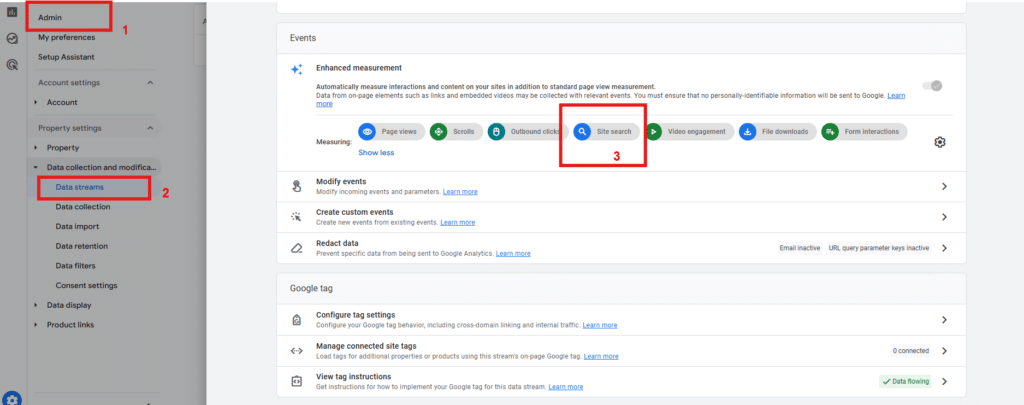Searching on websites can be an incredibly powerful way to improve the experience of visitors trying to find what they’re looking for. By optimizing your site search, you’ll provide a better journey that leads them exactly where they need and leaves them satisfied with their results.
In this post, we’ll explore how best practices like advanced solutions and strategies could help tackle common issues related to website searches – so let’s get started on our mission towards providing seamless access!
What is an Internal Site Search?
Internal site search is a feature that allows users to search for content, products, or information within a specific website using a built-in search function.
Unlike external search engines like Google, which index and retrieve content across the entire web, internal site search is designed to help users navigate a website more efficiently by providing relevant results based on their queries.
A well-optimized internal search function enhances user experience by delivering accurate, fast, and relevant results.
It enables visitors to find exactly what they need without manually browsing through multiple pages, reducing frustration and increasing engagement.
Businesses can also leverage internal search data to gain insights into customer behavior, identify content gaps, and refine their website’s structure to improve overall usability.
Importance of Effective Internal Site Search

The power of a well-crafted and optimized search within your website is often underestimated. It plays an essential role in providing users with a better site experience while also helping increase conversions and provide insight into user behavior.
Here are some key reasons why internal search on websites is important:
-
Enhancing User Experience
A well-optimized search on a website can have an immensely positive effect on user satisfaction by providing quick and relevant outcomes while reducing difficulties.
To ensure the best experience, certain features should be included in your site’s search function: simple forms with mobile compatibility, efficient navigation through results, and analyzing searches to recognize user behavior patterns.
When users struggle to find what they need, something may be wrong with the search algorithm or filters, requiring immediate adjustments.
However, having access to precise answers boosts the overall user journey as it allows them hassle-free findings of what they require quickly without taking up too much time or effort.
-
Boosting Conversion Rates
Site search plays an essential role in impacting conversion rates. By ensuring that users can easily find the items or content they are looking for, transactions and user involvement will be more likely to happen.
A common technique used to refine the results of a searched keyword is Searchandizing, which showcases higher-profit products on top of the list.
Research has proven that even though a smaller portion of all customers make use of site searches, these people provide substantial contributions when it comes to revenue gained by sites overall.
-
Monitoring User Behavior
Exploring the vast amount of site search data available can give you an invaluable understanding of user behavior and help guide your marketing strategies.
With resources like Google Analytics, heatmaps, and session recordings, you can gain deeper insights into user behavior and search trends.
In addition, site search analytics provide a comprehensive view that allows for correlating information from various sources to fine-tune your website’s capabilities according to customers’ needs and improve their overall experience.
Tips for Internal Site Search Optimization

Optimizing your internal site search ensures that users can quickly find relevant content, improving their experience and increasing engagement. Below are key strategies to enhance your site search and make it more effective.
-
Designing an Intuitive Search Bar
A search bar is essential for connecting users to content and products. It should include a text field, a clear magnifying glass icon, and a visible search button. Placement at the top of the page or header ensures easy access and encourages use.
A clean, uncluttered design with distinct colors improves usability and recognition. Optimizing the search bar for mobile devices ensures a seamless experience across all screen sizes.
Brands like Uniqlo, Samsung & Turkish Airlines have done a great job efficiently utilizing their respective search bars – they’re worth learning from!
-
Implementing Auto-Suggest and Auto-Complete Features
Utilizing auto-suggest and auto-complete features can significantly improve users’ search experience. Such functions allow for:
- Rapid prediction and recommendations concerning query terms while typing are occurring
- Time savings as queries are constructed in a better fashion
- Relevant advice that takes into account past searches from both individuals, plus what other people have searched most often
Making this process more efficient, aiding site navigation through an uncomplicated interface.
The implementation must be done with care. Having ideas on display that make sense to visitors but don’t overwhelm them – allowing room only for manageable list suggestions belonging to various categories, highlighted within these choices before evaluation via A/B testing taking place.
-
Customizing Search Results
Optimizing site search requires customizing the results displayed to ensure that users can locate what they need quickly and effectively.
A practical method is Custom Ranking, which alters where on-site search pages rank at the top of those outcomes. Thereby enhancing accuracy and relevance in searching.
Providing filters and facets can help refine user searches by tailoring them specifically according to preferences for a more personalized process and better engagement rates leading up to conversions.
Setting up internal site search tracking in Google Analytics

Google Analytics is a powerful tool that can be used to examine how people are engaging with your website, including through site search tracking. This section will guide you on leveraging Google Analytics for internal site searching.
-
Setting Up Site Search Tracking
To set up site search tracking in Google Analytics 4, users must enable the ‘Site Search Tracking’ setting and insert the query parameter.

Various websites such as Optimize Smart, Loves DataAnalyticsMania, and GlowMetrics, among others, offer step-by-step instructions and tutorials on how to do this correctly so that a great user experience is achieved when searching for something specific on your website or blog via Google searches engine results page (SERP).
Once configured properly with all of its settings complete through appropriate web analytics tools like those mentioned above, data generated from any related queries can be analyzed within GA under Behavior (Site Search). Usage report, which displays metrics such as ‘Total Unique Searches’ along with their actual terms entered by visitors looking for something specific.
-
Analyzing User Behavior and Search Patterns
Google Analytics offers several features and tools to assess user activity, such as the Users Flow report, which reveals potential issues with content engagement.
You can also utilize Segment Analysis in GA to better comprehend how various groups interact on your website – a crucial step for creating an optimal search experience that meets users’ needs.
Examining their searches via Site Search is another helpful way of identifying areas where you may be missing out on providing relevant material.
Advanced Site Search Solutions

In order to offer an individualized and engaging search experience for your users, it is essential to think of advanced solutions that can improve site search functionality, which includes integrating AI-powered search engines, voice searching capabilities, and visual searches. Implementing best practices in optimizing site search should not be overlooked either.
-
AI-Powered Search Engines
AI-powered search engines rely on AI techniques such as natural language processing and machine learning to offer accurate results based on the user’s query. By observing real-time behaviors, these tools can rank content according to its relevance for an enhanced personalized experience. Some popular options are Microsoft Bing, Google Bard, ChatGPT, You.com, etc.
Utilizing them allows one to upgrade their site’s search functionality plus internal engine, which offers tailored outcomes depending upon customer demands that keep changing over time whilst refining algorithms from past queries all with a single click away!
-
Voice Search Integration
Integrating voice search is an excellent way to improve the user’s overall experience of your site. The rise in mobile and tablet usage makes this option highly beneficial as it allows for more accessible searching with just a few words instead of manual typing.
Various platforms allow you to add such functionality, including Speechly, Amazon Echo, Algolia, and Spotify – as well as web browsers like Google Chrome, Mozilla Firefox, Microsoft Edge, and Safari.
-
Visual Search Capabilities
Your website’s search capability can be vastly improved by adding visual search. By offering a more intuitive and engaging user experience, this kind of searching allows users to quickly find content or products based on images rather than text.
Popular platforms like Google, Pinterest, Amazon, eBay, and Argos make use of AI algorithms in order to decipher visuals for searches, allowing people to explore your site by analyzing pictures alone!
By incorporating these kinds of technologies into your online space, you could see an increase in customer satisfaction through personalized results as well as quicker browsing overall.
Addressing Common Site Search Challenges

Managing site search can often be difficult, so this section will focus on common issues and ways to address them. Strategies for dealing with zero-results queries, balancing SEO demands while offering a positive user experience, as well as making sure that searches remain mobile-friendly are outlined in order to enhance your website’s search functionality and give visitors an enjoyable browsing journey.
-
Handling Zero-Result Queries
A zero-result query occurs when users search for something and receive no relevant results.
To reduce these instances, it’s essential to refine SEO and ensure proper content indexing.
If too many searches return no results, check whether relevant content exists but isn’t properly categorized or optimized. Analyzing failed searches can help identify content gaps and areas for improvement.
Optimizing search algorithms, refining indexing methods, and incorporating long-tail keywords can increase the chances of returning relevant matches.
Additionally, providing alternative content or suggested related searches can help guide users toward useful information instead of leaving them with no results.
Offering recommendations for related products or categories ensures users remain engaged and find value in their search experience.
-
Balancing SEO and User Experience
Finding the right balance between SEO optimization and user experience is crucial for effective site search.
While SEO helps bring in organic traffic, the user experience ensures visitors can navigate and find what they need.
Analyzing search data allows you to understand how users interact with your search function and make necessary adjustments.
Optimizing for natural language queries, incorporating long-tail keywords, and utilizing structured data can improve search accuracy while ensuring that content is user-friendly.
Featured snippets and well-organized search results help both search engines and users find relevant information quickly. A well-balanced approach ensures that search engines rank your site favorably while providing an intuitive experience for visitors.
-
Ensuring Mobile-Friendly Search
With mobile searches becoming more prevalent, ensuring that your site’s search function is optimized for mobile devices is essential.
A responsive design, fast-loading search results, and an intuitive interface contribute to a smooth mobile experience. Mobile-friendly search should be easily accessible, with properly scaled input fields and clear navigation.
Improving website speed by compressing images, using lightweight HTML5 elements, and avoiding intrusive pop-ups ensures that mobile users can search without delays.
Testing site search across different devices helps identify usability issues and confirms that the experience remains consistent across screens.
A well-optimized mobile search function increases engagement and improves conversions, whether users are browsing on desktops, smartphones, or tablets.
Final Thoughts
Site search can be a powerful tool to improve user experience and boost conversion rates while providing useful insights about user behavior.
To achieve this goal, following best practices when creating your site’s search function is essential, from advanced solutions for common challenges to making sure users get the most efficient experiences possible.
In doing so, you will make the most of your website by leveraging it as an invaluable asset for enhancing customer engagement and business growth.
Internal Site Search FAQs
What is an internal site search?
Internal site search is a search function built into a website that allows users to find specific content, products, or information within that site. Unlike external search engines like Google, internal search is limited to the website's indexed content, helping users navigate more efficiently. A well-optimized internal site search improves user experience, reduces frustration, and increases engagement by delivering relevant results quickly.
How to search for something inside a website?
To search for something on a website, you can use the site's built-in search bar, typically located in the header or sidebar. Enter your query, and the site will return relevant results from its indexed pages.
If the website doesn’t have an internal search function, you can use Google’s site-specific search by typing:site:example.com your search term
This will display results only from the specified website. There are keyboard shortcuts to assist in finding words and phrases on a web page, such as Ctrl + f (for Windows/Linux/ChromeOS) and Command + f for Mac users.
How do I prevent the crawling of internal site search URLs?
To prevent search engines from crawling internal site search URLs, you can block them using the robots.txt file.
Add the following directive: User-agent: *
Disallow: /search?
This tells search engines not to index URLs containing "/search?". Another option is to use meta robots tags (noindex, nofollow) on search results pages to prevent them from appearing in search engine results.
What is internal searching?
Internal searching refers to the process of users searching for content within a specific website using the site’s own search function. It helps visitors quickly locate information without manually browsing through multiple pages. Businesses use internal search data to analyze user behavior, identify content gaps, and optimize search algorithms for better accuracy.
What is an internal site search URL?
An internal site search URL is the web address generated when a user performs a search within a website’s built-in search function. It often includes query parameters that indicate the search term entered by the user, such as example.com/search?q=product.

